A New Way to Dice and Julienne
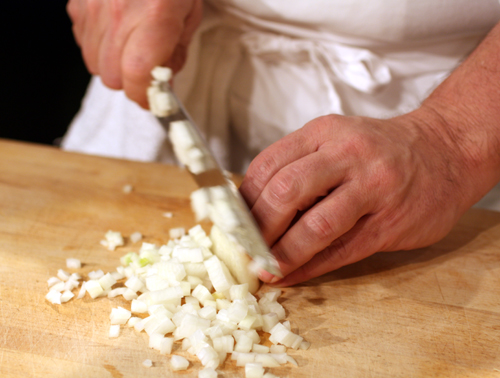
Palo Alto cooking instructor Peter Hertzmann was kind enough to invite me to be a guest at his recent knife skills class at Sur La Table in Los Gatos. You may recognize his name from his regular comments posted on my FoodGal blog.
Admittedly, my brunoise may not be the world’s most perfect looking, but I know my way comfortably around a chopping board and chef’s knife. Even though Hertzmann is the author of “Knife Skills Illustrated: A User’s Manual” (W.W. Norton & Company), I did wonder just a tad how much new information I would pick up from the class.
The answer? A whole heck of a lot.
Just as my pilates instructor often points out to me that I have a bad habit of standing with one hip higher than the other, Hertzmann quickly noticed that I don’t always stand facing the chopping board straight on. Yes, another odd quirk, probably because I’m so used to talking to people while I cook that I naturally turn my body toward them.
Among his other tips to the class: Avoid making a banging noise when the knife blade forcibly hits the chopping board. In other words, don’t wield your knife like an axe against your vegetables. Use a quieter sawing motion instead.
But what I will forever be indebted to Hertzmann most for is showing me an ingenuous way to dice an onion and to julienne a carrot more quickly. Here’s how to do it. We’ll start with the onion first. (By the way, in the top photo, those are Hertzmann’s hands. In the next photos below, the hands belong to my husband, aka Meat Boy.)
The classic way to dice an onion starts with cutting the peeled onion in half through the root and stem ends. Take one half of the onion, cut side down on the board, and make parallel horizontal cuts from the stem end to the root end, without cutting through the root end. Next, make parallel vertical cuts, again keeping the root end intact. Finally, make successive vertical cuts across the cuts you just made, thereby creating individual tiny cubes. If any of this is confusing, Hertzmann’s book is full of step-by-step illustrations.
Now, here’s Hertzmann’s way to dice an onion with fewer steps: Place one half of the onion, cut side down on the board. Again, keeping the root end intact, make a series of fan-shaped cuts around the onion, with your blade starting on top of the dome of the onion and aiming toward an imaginary center mark on the onion each time. Continue doing this until you have made cuts around the entire dome of the onion.
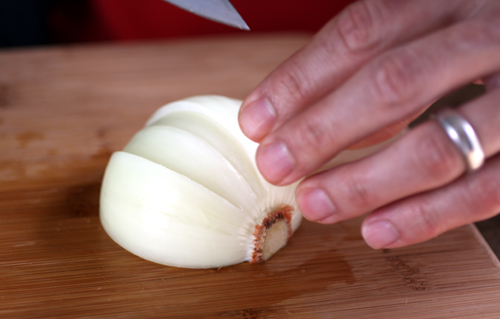
Now, make successive crosswise cuts, which will leave you with tiny cubes. Voila!
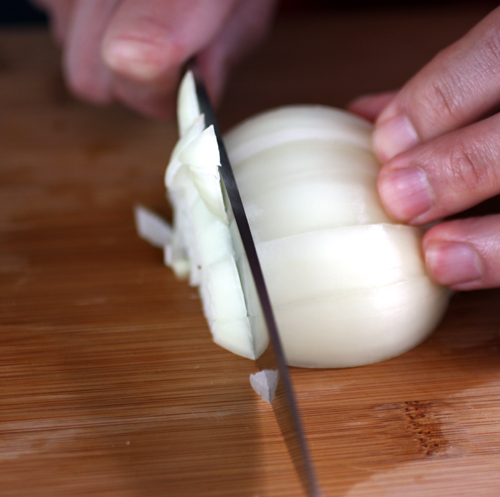
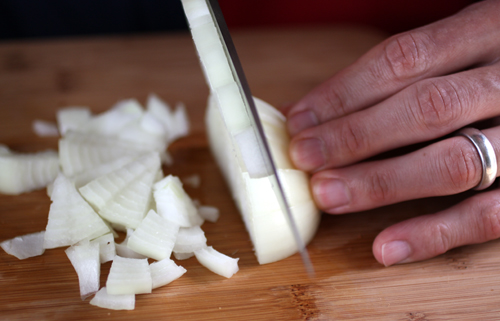
Hertzmann says he’s even seen the Food Network’s Alton Brown adopt this method of dicing now.
The classic way to julienne a carrot is fairly laborious. It’s why I often dread having to do it. You must trim the carrot so that it is no longer conical, but rather cube-like, with flat edges so it will not roll around on your cutting board. Then, you must cut thin planks. Finally, you make successive cuts through the long edge of the planks to produce the julienne. Whew.
With Hertzmann’s method, you simply slice your carrot at a sharp angle, producing elongated ovals.
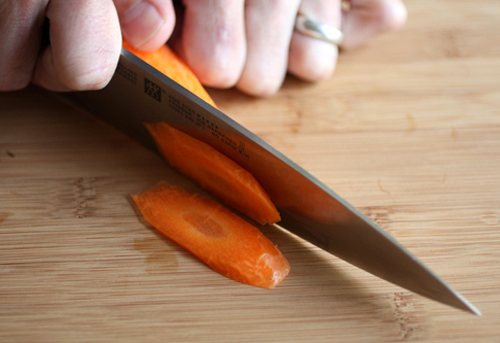
Then, you stack three or four of the ovals on top of one another, and make successive cuts through the length of them, creating the julienne. How easy is that?
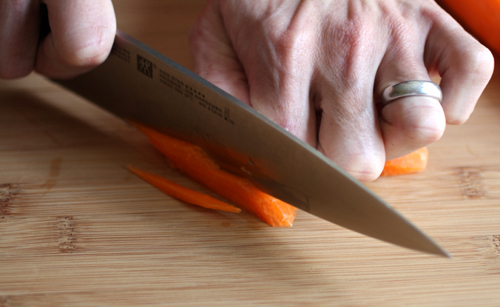
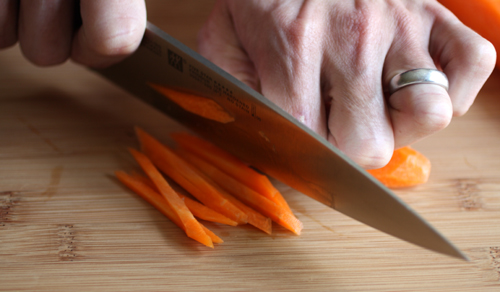
I can’t say I now can chop at the speed of light while not even looking at what I’m cutting la cleaver-wielding Martin Yan. For sure, I’ll need a lot more practice before I can master that. But I did come away with invaluable techniques I have since put into practice regularly.
Merci beaucoup, Peter.

I love the carrot julienning technique! Can’t wait to use that.
I took a knife class at California Culinary Academy a while back, it was really helpful. And Martin Yan actually stopped by and taught us how to julienne carrots!
Thanks for the kind words, Carolyn. It was nice having you in class. The next one at the Los Gatos store is scheduled for Tuesday, April 28th. It looks like it will be a small class, i.e. lots of personal attention.
One comment: Meatboy needs to work on how he’s holding the food with his left hand. If either he (or you) is going to get to the point of cutting without looking, that’s were the work needs to be. It also helps with building speed and accuracy.
I’ve got the onion skill down pat but I’m definitely going to adopt Hertzmann’s carrot technique from now on. Julienne for everyone!
That carrot technique is pure genius. Why didn’t I ever think of that?
Oh does that ever make this experienced (read “old”) cook feel proud! I’ve been doing onions that way forever, and just never figured I needed to “julienne” a carrot badly enough to do anything more than cut thin slices of thin ovals, squared-off ends be darned. If I’ve got permission now to call that method professional, I will go forth happily and slice those little carrot strips into curvy little matchsticks with great joy.
Peter, I will try to convince my kitchen-proficient grown-up son to take one of your classes with me very soon. I deeply need help getting the hang of that bent-knuckle food hold, as the scars on my fingertips will readily attest.
That’s a great way to cut the carrot! I usually cut carrots into big oval coins like that when I add them to stir fry. I’ll try that method of onion-cutting, too – I’m generally pretty quick about it and my eyes rarely sting, but the less cutting there is, the less chance of getting onion fumes in your eyes!
Oh, yeah, and another thing: when dicing the onion, use the hand NOT HOLDING THE KNIFE (a.k.a. the “free hand”) to wipe the tears from your eye. Safety first!
Susan C: I know the feeling. When Peter demonstrated the julienning technique, I just wanted to slap my forehead and yell out, “Why didn’t I think of this before?!? Duh!!”
Peter: Oh, both Meat Boy and Food Gal need to work on holding the veggies better, believe me. Hah! That’s why I can’t do the eyes-closed chopping method yet. But some day, some day….
Smarty pants: I don’t think you want to wipe your eyes with the hand not holding the knife. Because that’s the hand that touched the onions. Wiping your eyes with that would only make matters worse!
Glad to know I was already doing onions right, but the carrot technique is new to me.
Here’s a tip I will add to the mix: When cutting a stalk like celery or green onion, start by making some lengthwise slits at the wide end, splitting the broadest end into thinner pieces. The thinner ends will still be attached. Then slice. This way, your pieces are uniform.
I’ve never cut the carrots another way in my life, so I don’t really know how others julienne their carrots. That’s how my grandma taught me, and that’s how i do it. 🙂
Carrots usually get the peeler treatment – sort of a poor man’s mandolin. It results in much more surface area / volume so more flavor. Great in fresh salads.
For onions: I quarter them (cut off the top, but leave the root), slice down, rotate so the other cut side is down and slice down again. That way all the cuts are vertical – that traditional sideways slice with the edge pushing into my left hand gives me the willys.
Oh, and whenever I can make it work, I trade the dice for a “royale” (maybe not the right term) onion cut: remove both ends and make very fine fan cuts (like meat-boy) all the way through. the resulting fine crescents caramelize more easily and retain an identifiable onion-ness better than dicing.
wow! thanks for the tutorial! i’ve always found julienning carrots to be pain!
awesome!! this looks like such a better way to do the carrot.
i SO need to take Peter’s class but being unemployed sucks. 🙁 If he ever offers a scholarship for it I am so there! Especially since I live right near the sur la table in Los Gatos.
Pingback: Foodie Link Roundup for Easter Weekend : Blisstree - Health, Wellness and LIfestyles
Thanks for the tips! Those are really useful. 😀
Great tips! I especially appreciate the advice on how to julienne a carrot – who knew? I would love to take that class.
Thanks for sharing this Carolyn!
Excellent information! I will have to check out on of these classes. Thanks for sharing!
I really need help with my chopping. I recently lopped off a piece of my thumb chopping an onion. I once took a cooking class in Thailand, and the women there laughed at me and said, “You don’t cook much do you?” All because my chopping technique is so terrible. This is helpful, but that knife looks pretty close to the fingers.
Grubtrotters: Thumb lopping. Yes that’s a pretty good sign yer not doin it right.
One really good idea is to hold food using “the claw.” Cup your hand over the food, so your fingers make a claw shape. Hold the food with just the fingertips, making the top of the fingers into a vertical wall.
Now keep the top of the nife on the board and raise and lower the heel. The flat of the knife is near the wall your clawed fingers made, making it impossible to get fingertips under the sharp edge.
Oh, and keep the knives sharp. Dull knives slip and make ghoulish kitchen scenes that involve Band Aids and cursing.
I’m pleased to see that I’m dicing my onions properly and efficiently and the julienne tutorial is great! By any chance, By any chance, did Peter Hertzmann (or you) have an opinion regarding the use of a santoku knife versus a chef’s knife? The latter has served me quite well but I wonder if I should also have a santoku.
Grubtrotters: Oh my! That sounds painful and scary. Be careful!! Though, I’m the person who once locked the car door on my thumb. Ouch! But that’s another story….
Tangled Noodle: I also use a santoku as my go-to knife. I asked Peter about that in the class. He says the only problem with the European-style santoku that I use (it’s a Henckels) is that unlike a Japanese one, it is almost flat-edged on the bottom, unlike the Japanese santokus that are curved more and thus allow a more natural rocking motion when cutting.
I took a cooking class a few years back, and yes, the chef spent a great deal of time teaching us the proper way of cutting/chopping/dicing. I have to admit that I fell back to my old, bad habits pretty quickly after that. Thanks for the refresher!
Thanks, Moe. I’ll have to try the claw!
I love knife tips but never feel like I’m in a rush when prepping, so I go pretty slow anyway. We recently invested in some really great Shun Classic knives. I’m afraid to use them, they’re so sharp! (I always had the worst cheapest and most dull knives before).
I’d love to know what knives are in your kitchen. Please share if you can.
I love my Shun santoku knife. I find myself going for it most of the time, other times for a Henckels 8″ chef knife.
Knife recommendations: I wrote about what knives I have and why here:
http://feedme.typepad.com/my_weblog/2005/08/nice_knives.html
Moe: Shun knives are great. I’ve only used them in classes, but I do like the way the blades are shaped and are so sharp.
Lisa: There’s nothing wrong with being slow. Believe you me, I am no speed demon, either, when it comes to chopping. The important thing is to just get the job done — carefully, and so that you end up roughly with what you wanted. 🙂
I use Henckels knives, only because when I finally went to buy a decent set of knives at Macy’s, why, with perfect timing, the Henckel’s rep happened to be there that day in the store. I use the ergo-handle ones, which I know Cook’s Illustrated gave a scathing review to years ago. But I like how they feel in my hand. As Peter Hertzmann even told me, “Knives depend a lot on personal preference. How they feel in your own hand is what is most important.” For instance, I love the sharpness of Global knives. But I don’t like how a metal handle feels in my hand.
And don’t be afraid of using a sharp knife. It really is safer than using a dull one. It takes a lot more pressure and effort to cut through something with a dull knife, so your chances of hurting yourself are greater. In comparison, a sharp knife lets you cut through things effortlessly. I remember the first time I used my Henckels, after being used to using only cheapo knives. When I sliced through an onion for the first time using my Henckels, I practically screamed. I could not believe how easy it was to cut the onion, even into the thinnest slices. I barely had to use any force to do it. It was a thing of magic.
Also, remember to run your knife along your steel before every use. It helps realign your blade and keep it in good shape.
I just got a steel Shun Santoku knife last week and it is incredibly sharp! I used it to cut onions yesterday so effortlessly, it made me realize how dull my Henckels knives are. Time to get them sharpened!
Can I also add that OXO has a fabulous tool for making julienned strips. OK, it’s not classic, and they’re a little thin, but listen, when it’s noon and I want a fresh salad for lunch, nothing beats the convenience.
And we, too, have a full drawer of Henckels knives. And I could care less what the people at Cook’s Illustrated say. They feel great in the hand.
Well, is it time to segue into corkscrews yet? If not, I’ll just sit in the corner and wait … (sigh)
Smarty pants: Corkscrews! Anyone want to go there next? hah! I use a Rabbit-like corkscrew when I’m entertaining, because it opens bottles fast, and anyone can pretty much use one. But usually for my everyday one, I use the classic waiter’s style corkscrew. It’s simple, compact, and gets the job done. It also fits easily in my over-stuffed gadget drawer in the kitchen.
Great tutorial, I am glad I still seem to remember the basics from my knife skills class, and now just need to see about getting my husband enrolled. I cringe every time he uses my knives (I’m very possessive of those babies) as he has an axe technique so I spend a lot of time sharpening or getting them profresionally sharpened.
What a great conversation this post has generated!
We still use an “ah-so” for opening wine bottles — mainly because when we first saw one years and years ago it just seemed so totally cool. There are still people who come to our house and have never seen one so it continues to generate the “Oh wow!” reaction.
What can I say? Since we’re constantly behind the curve with technology stuff (compared to our kids) we look to get some cred wherever we can 🙂
My new-within-the-past-year-and-how-did-I-ever-live-without-it Santoku knife is a not-fancy-at-all Cuisinart version, but the heft feels exactly perfect in my hand. A friend gave me a smaller version of the same one for Christmas, and I almost never use it — just doesn’t feel right.
While we’re at this, does anyone ever use a stone instead of/as well as a steel? I inherited one of each from both sides of our family, and am never sure which or in which order it’s “best” to use them.
Carroll: actually, the holding technique is not a bent knuckle. Check out this video: http://xrl.us/kkq7y
Smarty pants: if you slice rather than chop, and use a sharp knife, you’ll cry a lot less.
Grubtrotters: part of your problem may be that you are chopping instead of slicing. Knives work better and require less force if you always slice with them. See the video.
Moe: I’m not a fan of the “claw” as you can see in the video. It’s difficult to hold small objects with the method. Give my method a try—you may like it. Also, keeping the tip of the knife on the board always works fine for small objects but becomes increasingly difficult for thicker objects. For either type, it’s the slicing (or sawing) motion that is most important.
Tangled Noodle: I can work with a Japanese-style santoku, but I dislike the German-style santokus. With the German ones, the tip tends to dig into the cutting board when you cut with a rocking motion. The tips on the Japanese-style santokus curve up a bit more so this isn’t a problem. I prefer using a 10-inch or longer chef’s knife for most vegetable cutting, so santokus are a bit short for me. When they were first designed in 1903, they were intended for cutting short objects on small cutting boards, as for Japanese dishes. They are used in Japan with a diagonal, up-and-down (slicing) motion and not rocked like in Western cooking. If you are comfortable with a chef’s knife, i don’t see a need for having a santoku as well.
Smarty pants (II): I use a traditional waiter’s style cork puller. This one in particular is made in Italy and has a long screw as well as a built-in capsule cutter. I found it many years ago at the Henklel’s outlet store in Münich.
Carroll (II): I only use a steel on European knives. It’s function is not to sharpen (remove metal) but to straighten the edge that becomes rolled over from use. For my much harder steel Shun knives I find that neither a steel or a stone is necessary, and not recommended. With their lifetime warranty, I can just send them back to the factory for free sharpening when the time comes. My current ones have 2+ years of heavy use and don’t feel the least bit dull. Stones are great for sharpening the softer steel of other knives, but requires a craftsman. I use an Ozitech — http://xrl.us/beowcj — when I have to sharpen these knives. If a blade is in very bad shape, I use a Chef’s Choice Model 100 Electric Sharpener –http://xrl.us/beowcq.
*Commercial Plug*: if you come to my next knife skills class — http://xrl.us/beowdc, you’ll receive a 15% off coupon for anything in the store including knives. [Actually, the coupon is good for 15% off of anything except electronics the night of the class. The coupon is good for 10% off everything the following 6 days, and 10% off electronics on the first night.]
Thanks, Peter! Maybe someday you and I can have a mano-a-mano on “What’s a ‘Rabbit’ corkscrew?” I know she was putting me on, but I guess that’s what I get for a clumsy attempt to change the subject (As in, hey, you wanna talk about something else, get your own blog?!) And as for the onion dicing, am I correct in understanding that step one is really peeling the vegetable? and if so, how do you get past step 1 w/o crying? Maybe I should change my name to SLOW-LEARNER.
Peter, thank you so much for the clarifications! I really appreciate that you took the time for this good response to all the questions. Since I live in Cupertino, your classes are well within range, and certainly of real interest to me. I’ve already checked the website and passed the information along to my culinarily-inclined younger son (all grown up now, but still my “baby”) to whom I have promised a mom/kid class of his choosing. Hopefully our paths will cross in person with yours someday soon 🙂
Smarty pants: Ye of little faith. I don’t make this stuff up. I’m a trained journalist, after all. Take a peek at this: http://www.rabbitcorkscrew.com/
Maybe you should spring for one. Or, err, hop for one? 😉
Rabbits and “worms” messing around with your nice bottle of wine? Yeesh!
Smarty pants, you know, one of these days you and I non-bloggers could easily band together and completely hijack the comments here 🙂
Wow! Those rabbit corkscrews are fantastic! & you can save $26 on the VIP edition by placing your order por tiempo limitado (and for only $4.95 & ground shipping, you’d be a fool not to invest). Carolyn, can you ever forgive me? [Hold it — $26 is about $23 more than I’ve ever spent on a corkscrew. When my wife and I celebrated our 14th wedding anniversary at the Monterey Bay Inn, they gave me a nice compact unit that requires muscular tension rather than mechanical power, but we still have it as a momento.]
Thanks for sharing the tips. I’ve been doing it old-school way for forever, but these little tweaks are brilliant. Especially the carrot trick. Thanks Peter, for teaching them. To continue the comment conversation, we use wusthof’s and love them. Although those Shun’s are very tempting if they stay as sharp for as long as people are saying. After reaching an initial quality level, I think a lot of knife preference comes down to how the balance and feel is for the individual holding it, as long as they are holding the knife properly. Everyone’s hands are different, and what’s great for one, might not be for another. But when you find that match, it’s becomes a part of your hand. Thanks again for sharing the tips. Todd.
Nice info and photos. I thought the onion method sounded familiar… I first heard of it in Alton Brown’s show.
I usually turn to the mandoline for juliennes but I really should learn this with a knife. Kind of tougher with a wide Chinese blade, though.
Pingback: Food Gal » Blog Archiv » Global Knife Give-Away — Yeah, That’s What I’m Talkin’ About
Pingback: Carrot Cashew Salad « the recipe mooch
Amazing! Thank you soooo much for this article! I’m glad I found it! 🙂
Pingback: Freezer Meal Recipes: Olive Garden Copycat Pasta e Fagioli Recipe | Fabulessly Frugal